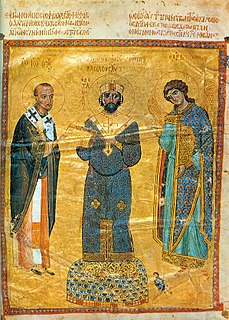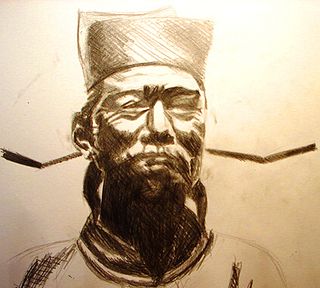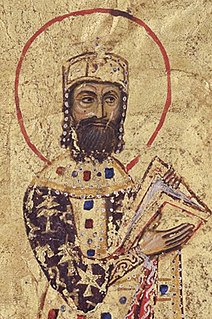Related Research Articles
The 1000s was a decade of the Julian Calendar which began on January 1, 1000, and ended on December 31, 1009.

Year 1135 (MCXXXV) was a common year starting on Tuesday of the Julian calendar.
Year 1071 (MLXXI) was a common year starting on Saturday of the Julian calendar.
The 1060s was a decade of the Julian Calendar which began on January 1, 1060, and ended on December 31, 1069.
The 1100s was a decade of the Julian Calendar which began on January 1, 1100, and ended on December 31, 1109.
The 1050s was a decade of the Julian Calendar which began on January 1, 1050, and ended on December 31, 1059.

Year 1078 (MLXXVIII) was a common year starting on Monday of the Julian calendar.
The 1120s was a decade of the Julian Calendar which began on January 1, 1120, and ended on December 31, 1129.
The 1110s was a decade of the Julian Calendar which began on January 1, 1110, and ended on December 31, 1119.
The 1080s was a decade of the Julian Calendar which began on January 1, 1080, and ended on December 31, 1089.
Year 1118 (MCXVIII) was a common year starting on Tuesday of the Julian calendar.
The 1010s was a decade of the Julian Calendar which began on January 1, 1010, and ended on December 31, 1019.
The 1030s was a decade of the Julian Calendar which began on January 1, 1030, and ended on December 31, 1039.

Year 1073 (MLXXIII) was a common year starting on Tuesday of the Julian calendar.

Year 1074 (MLXXIV) was a common year starting on Wednesday of the Julian calendar.

Year 1075 (MLXXV) was a common year starting on Thursday of the Julian calendar.

Year 1077 (MLXXVII) was a common year starting on Sunday of the Julian calendar.

Year 1081 (MLXXXI) was a common year starting on Friday of the Julian calendar.

Year 1085 (MLXXXV) was a common year starting on Wednesday of the Julian calendar.
The 1020s was a decade of the Julian Calendar which began on January 1, 1020, and ended on December 31, 1029.
References
- 1 2 3 4 5 Palmer, Alan; Veronica (1992). The Chronology of British History. London: Century Ltd. pp. 53–55. ISBN 0-7126-5616-2.
- ↑ "British History Timeline, Norman Britain, BBC" . Retrieved 2007-12-23.
- ↑ Williams, Hywel (2005). Cassell's Chronology of World History . London: Weidenfeld & Nicolson. pp. 112–113. ISBN 0-304-35730-8.
- ↑ William of Malmesbury.
- ↑ "The History of Canterbury Cathedral". Archived from the original on October 27, 2007. Retrieved December 23, 2007.
- ↑ Adam of Bremen. Gesta Hammaburgensis ecclesiae pontificum .
- ↑ Kleinhenz, Christopher (2010). Medieval Italy: an encyclopedia. New York: Routledge. p. 95. ISBN 978-0-415-93930-0.
- ↑ John Julius Norwich (1991). Byzantium: The Apogee – The Disaster, p. 357. ISBN 0-39453779-3.
- ↑ Brian Todd Carey (2012). Road to Manzikert: Byzantine and Islamic Warfare (527–1071), p. 155. ISBN 978-1-84884-215-1.
- ↑ Fletcher, R. A. (1987). "Reconquest and Crusade in Spain c. 1050-1150". Transactions of the Royal Historical Society. 5. 37: 31–47 [35]. JSTOR 3679149.
- ↑ Canellas, Angel (1951). "Las Cruzadas de Aragon en el Siglo XI". Argensola: Revista de Ciencias Sociales del Instituto de Estudios Altoaragoneses. 7. ISSN 0518-4088. Archived from the original on July 15, 2014. Retrieved February 22, 2012.
- ↑ Brian Todd Carey (2012). Road to Manzikert: Byzantine and Islamic Warfare (527–1071), p. 155. ISBN 978-1-84884-215-1.
- ↑ David Nicolle (2003). The First Crusade 1096–99: Conquest of the Holy Land, p. 12. ISBN 978-1-84176-515-0.
- ↑ Alexander Daniel Beihammer (2017). Byzantium and the Emergence of Muslim-Turkish Anatolia, Ca. 1040-1130, p. 210-212.
- ↑ Stratton, J.M. (1969). Agricultural Records. John Baker. ISBN 0-212-97022-4.
- ↑ Minguez Fernández, José María (2009). Alfonso VI/Gregorio VII. Soberanía imperial frente a soberanía papal, pp. 30–33. ISSN 1575-801X.
- ↑ Canellas, Angel (1951). "Las Cruzadas de Aragon en el Siglo XI". Argensola: Revista de Ciencias Sociales del Instituto de Estudios Altoaragoneses. 7. ISSN 0518-4088. Archived from the original on July 15, 2014. Retrieved February 22, 2012.
- ↑ "Fires, Great", in The Insurance Cyclopeadia: Being an Historical Treasury of Events and Circumstances Connected with the Origin and Progress of Insurance, p. 25. Cornelius Walford, ed. (C. and E. Layton, 1876).
- ↑ Claude Cahen (1968). Pre-Ottoman Turkey: a general survey of the material and spiritual culture and history c. 1070–1330. Trans. J. Jones-Williams, pp. 73–74 (New York: Taplinger).
- ↑ Grape, Wolfgang (1994). The Bayeux tapestry: monument to a Norman triumph. Prestel. ISBN 978-3-7913-1365-8 . Retrieved 2012-05-03.
- ↑ Cowdrey, H. E. J. (1998). Pope Gregory VII, 1073–1085, p. 279. Oxford: Clarendon Press.
- ↑ John Julius Norwich (1991). Byzantium: The Apogee, p. 361. ISBN 0-394-53779-3.
- ↑ Martin, Janet (1993). Medieval Russia, 980–1584, pp. 33–35. Cambridge University Press. ISBN 978-0-521-67636-6.
- ↑ Dehsen, Christian D. Von; Harris, Scott L. (1999). Philosophers and Religious Leaders. Greenwood Publishing Group. p. 10. ISBN 9781573561525.
- ↑ Richard Brzezinski (1998). History of Poland: The successors of Bolesław the Brave, p. 19. ISBN 83-7212-019-6.
- ↑ "Take a stroll through a piece of old England" . The Independent. December 12, 2004. Archived from the original on May 1, 2022. Retrieved 28 July 2018.
- ↑ Brian Todd Carey (2012). Road to Manzikert: Byzantine and Islamic Warfare (527–1071), p. 159. ISBN 978-1-84884-215-1.